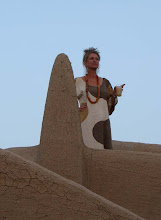
Djenne Library archivists Garba Yaro (left) and Yelpha Dieité work on manuscripts at Master Kanta’s Koran school.
Two areas of manuscripts were surveyed:
1. The Djenné Library Collection
2. Manuscripts held at family residences.
The month of Ramadan fell during the first month of the project. It was decided that visits to individual families would be better postponed until the end of Ramadan and therefore the team concentrated on the listing of the Djenné Library collection for the first month.
The Djenné Library contained 1519 Manuscripts at the beginning of the project, donated by 24 families. By the time the project ended, 9 further families had given another 653 MSS, thus bringing the Djenné Library Manuscript collection to a total of 2172. These last acquisitions have not been listed yet, since the team was concentrating on the private collections for the three last months of the project following Ramadan, making daily visits to the homes of the owners who had agreed to show their manuscripts.
13 families opened their doors and their MSS collections to the team. Often several days were needed to sort through numerous chests and boxes storing the documents. The owner of the collection was invariably present, sometimes insisting on touching the manuscripts himself only. In the majority of cases several visits were necessary, and the team had to fit in with the owner’s schedule.
In order to gain a rapid overview of the material available for viewing it was decided that the manuscripts should simply be counted. Information with regards to content was gathered by devising a sheet with 30 descriptive headings such as ‘the Holy Koran’ , Jurispr udence, Astronomy, Rhetoric etc. and each manuscript was entered with a tick on the sheet in its respective category. Each family collection is represented by one such sheet only at the present moment, and these 13 sheets are the most relevant result of the present survey.
The 30 descriptive headings on the sheet were made in Arabic and the notes were made in Arabic throughout the project, but translated into French by a member of Haidara’s translation team in Timbuktu for the purposes of this report, and I translated it into English from the French.
Once a manuscript had been entered on the list, it was put between a folded sheet of ordinary white copy paper for safe keeping and to demarcate its entity as one manuscript. It was then returned to its storage trunk, which was in most cases a metal chest, a relatively safe storage place, and it remained in the majority of cases in the location it had been viewed.


0 Comments:
Post a Comment
<< Home